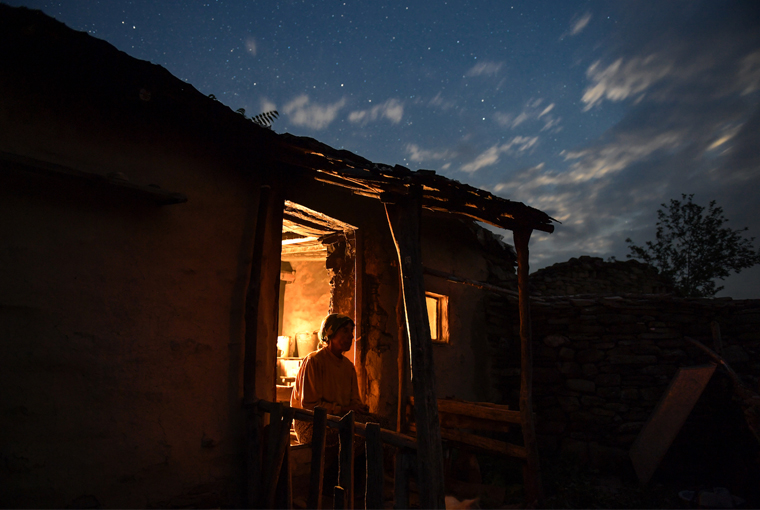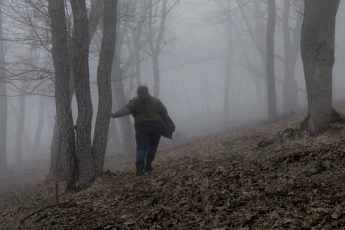A Taste of Honey
Tamara Kotevska and Ljubomir Stefanov’s Honeyland (2019)
Vol. 99 (November 2019) by Zoe Aiano
At first glance, it isn’t immediately obvious whether Honeyland is documentary or fiction. The film opens in the dramatic Macedonian countryside, with sweeping drone shots following the too-photogenic-to-be-true Hatidze as she traverses mountains and teeters along precarious ridges. As if in a fairy tale, at the end of a cliff edge she pulls away a seemingly normal piece of rock – like someone who knows the secret entry to an enchanted lair – to reveal a hive of bees. Even more surreal is the way she handles the bees, which spill out in a mass like a torrent of buzzing lava as she calls to them like a shepherd commanding a sheepdog.
This is the core of the film’s central premise – Hatidze and her bed-ridden mother are the last two residents of an abandoned village in Macedonia once inhabited by a Turkish community. She provides for their subsistence by collecting the honey from her small personal swarm, which she then takes to Skopje to sell in the market. Her relationship to bees and indeed to nature as a whole is predicated on the notion of sharing the spoils – she takes half the honey, and the other half is left for the bees themselves. Right on cue, in keeping with the dramatic arc of a more than averagely coherent festival fiction feature, an itinerant family moves in next door, jeopardizing this balance. Seeing that they also keep bees, and on a much larger scale, Hatidze takes pains to explain her philosophy, which is all the more poignant since if they fail to provide for the needs of their hives, it will pose a direct threat to hers, as the hungry bees will be forced to find other sources of nutrition.
At first, relations between the two sets of neighbors seem to be going well, despite the chaos heralded by the new arrivals and their seemingly infinite amount of children (“every year means another child”). One young boy in particular takes a shine to Hatidze, who in turn adopts him as a kind of beekeeping mentor. Before long, however, a big bad capitalist from the city turns up with an offer to buy the family’s honey, but only under the proviso that they deliver it in large quantities – all or nothing.
The documentary does an impeccable job of capturing this remarkable microcosm, and indeed perhaps directors Tamara Kotevska and Ljubomir Stefanov had an unexpected advantage in not being able to understand the local dialect of Turkish, and were therefore forced to rely on their visual storytelling instincts. Whatever the methodology behind it, the humanity of the characters shines through, even in the case of the neighboring family, who are essentially the disrupters. It would have been incredibly easy to outright demonize them, as some of the scenes are incredibly harrowing, with the children (and babies) clearly being traumatized from being routinely stung. Most upsettingly, at some point their calves start dying en masse, apparently of negligence. Despite this, the film takes pains to show them in a balanced light, as a family trying to do their best in difficult circumstances.
This nuance is also reflected in the much-lauded cinematography, which essentially consists of three modes. The first features epic, cinematic shots of the landscape that create a sense of drama and establish the setting as exotic (for better or worse). The second, and arguably most interesting, is formed of chaotic, fluid, erratic shots, often related to the interaction between humans and nature, especially animals. This style is used in the most compelling scenes, namely the frenzy of the family trying to round up the cows, failing miserably and being kicked and dragged through the mud, and also, of course, in their attempts to prove their mastery over the bees. By contrast, whenever Haditze interacts with her insects, the camera becomes almost elegiac, complete with lens flare and warm, Instagram hues.
The third category is that of the quiet, still moments that relate to familial intimacy. Especially within the confines of their simple home, the film focuses on Hatidze’s solitude in conjunction with her simultaneous devotion to and affection for her ailing mother. Of course, she doesn’t want her mother to die, but until she does Hatidze will have no opportunity to alter her circumstances. In this sense, the stance of the film is somewhat unclear. On the one hand, Hatidze is presented as the last exponent of an ancient tradition and thereby also a paragon of an almost-lost connection to nature. On the other, she is also burdened by this role, which not only leaves her vulnerable to external interruptions from the modern world, it also prevents her from being a part of a community. That said, this absence of a clear thesis may well be an intentional reflection of the complex nature of Hatidze’s position rather than an oversight in an otherwise perfectly structured work. Indeed, if there is a flaw to be found in Honeyland, it lies precisely in this neatness, which is always suspicious in a documentary.




Leave a Comment